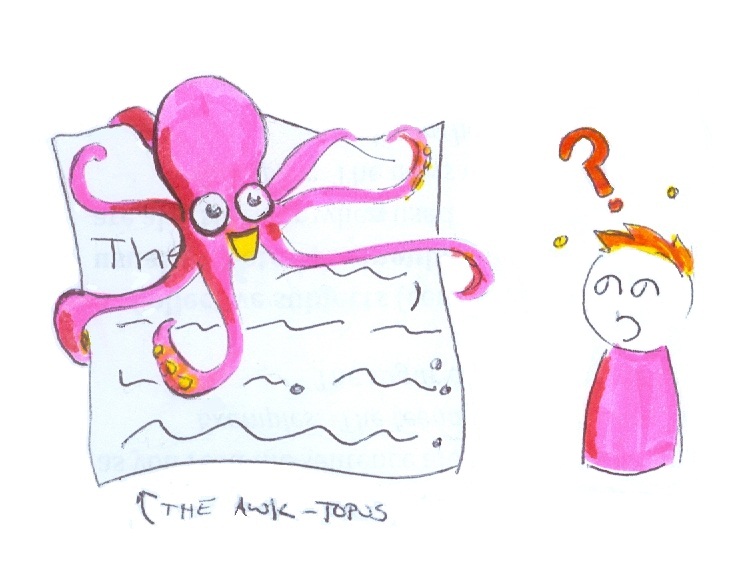by Genevieve Bergeson
Instead of imperiling my career in comedy (i.e., making a bad joke), I’ll cut to the chase: today we will explore how cephalopods and sentences are similar, that is, octopi and the syllable “awk.” “Awk” is what professors and colleagues write in the margins of our writing next to confusing—awkward—sentences. Ah, but you probably want to hear the joke anyway.
Why didn’t the cephalopod share his writing?
Because it was too oct-word.
 So, “awkward.” What constitutes an “awkward sentence”? Essentially, the individual parts of the sentence (phrases, clauses, etc.) don’t quite fit together; this in turn makes the meaning unclear or confusing. Instead of following the main idea (head) of the sentence (octopus), the reader gets tangled in the tentacles (phrases & clauses). On the other hand (or tentacle), the parts of an effective sentence work together smoothly to propel your denizen of deep thinking forward.
So, “awkward.” What constitutes an “awkward sentence”? Essentially, the individual parts of the sentence (phrases, clauses, etc.) don’t quite fit together; this in turn makes the meaning unclear or confusing. Instead of following the main idea (head) of the sentence (octopus), the reader gets tangled in the tentacles (phrases & clauses). On the other hand (or tentacle), the parts of an effective sentence work together smoothly to propel your denizen of deep thinking forward.
Awkward sentences (awk-topi) appear for several reasons, grammatical and otherwise. Perhaps you’re simply squirting ink and ideas everywhere because you haven’t figured out how to articulate them yet. Perhaps you’re unaware there are principles and strategies to help you eliminate awk-topi. Either way, my punny scientist friends Seth and Steph Allopod recommend this octet for eliminating awkwardness and making writing clearer.
Ready? Let’s get kraken!
- Make sushi. (I’d say “calamari,” but that’s literally another animal.) Don’t cram too much into one sentence; separate the ideas into more manageable bites.
- Be direct. Say your idea in as few words as possible.
- Delete unnecessary words and information.
- Parse the sentence. Mark subjects, verbs, objects, phrases, clauses, etc., differently so you see the parts of the sentence and how they interact. (Sometimes words get caught between related parts and interfere with the relationships of those parts—subject/verb, pronoun/antecedent, independent/dependent clauses. Be clear about who’s doing what.)
- Start fresh. Turn your paper over (or scroll to a blank page) and rewrite the entire sentence.
- Switch things around. Putting key words and ideas in different positions may reveal a more fluid grammatical structure, which makes it easier for your reader to understand your point.
- Check verb forms. Eliminate unnecessary and confusing tense shifts. Use active verbs (unless passive voice is more appropriate for the situation).
- Word choice. Does the word mean what you think it means? Are there more accurate terms you could use? When in doubt, consult a good dictionary.
Happy thinking!
Genevieve Bergeson, in her second year as a Principia post-graduate teaching intern in writing, delights in all things creative—art, words, and music. She has authored and illustrated the children’s book Racing Pajamas (read more at drawstheeventide.com) and has several other stories in the works.
